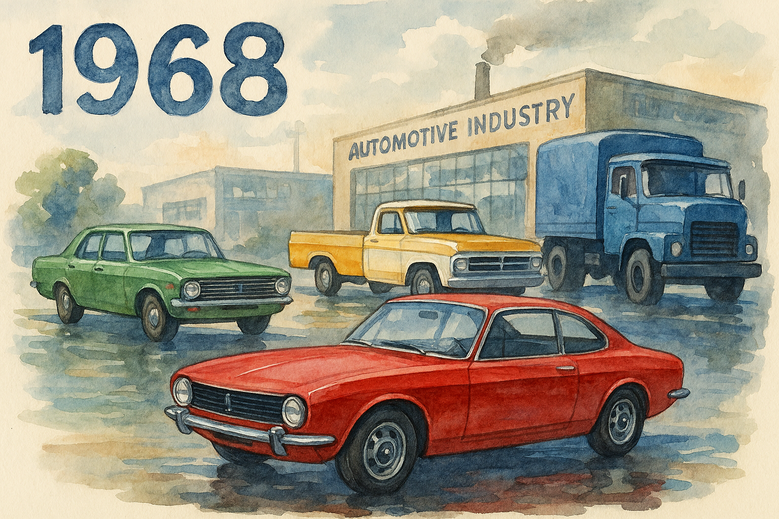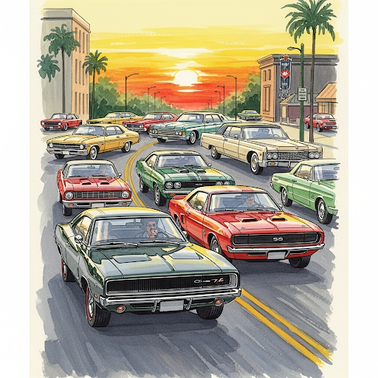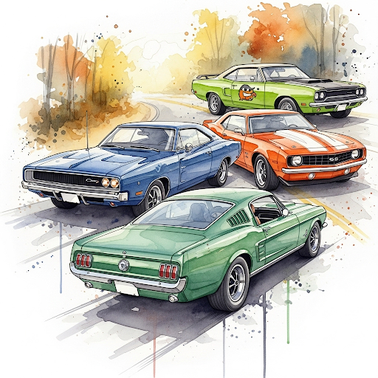1968: A Golden Year for American Automobiles
The year 1968 stands as one of the most celebrated years in automotive history, representing the peak of the muscle car era and a time when American manufacturers were pushing the boundaries of performance, style, and innovation. This was the year when horsepower wars reached their zenith and iconic designs emerged that continue to captivate enthusiasts today.

The Muscle Car Revolution
1968 marked the culmination of the muscle car movement that had been building throughout the 1960s. Manufacturers were cramming their largest, most powerful engines into mid-size chassis, creating affordable performance machines that captured the spirit of the era. The formula was simple yet revolutionary: take a relatively lightweight car and stuff it with a big block V8 engine designed for maximum power output.
The cultural backdrop was equally important. Post-war prosperity had created a generation with disposable income and a hunger for excitement. Baby boomers were coming of age, and the automobile became their symbol of freedom and rebellion. The music, fashion, and social movements of 1968 all contributed to an atmosphere where bold, powerful cars weren't just desired—they were essential expressions of identity.


Legendary Models That Defined the Year
The 1968 Dodge Charger R/T represents perhaps the most iconic design of the era. With its distinctive "Coke bottle" shape, hidden headlights, and aggressive stance, the Charger embodied the muscle car aesthetic. Under the hood, buyers could choose from a range of powerful engines, including the legendary 440 Magnum and the race-bred 426 Hemi. The Charger's combination of stunning looks and brutal performance made it an instant classic that would later achieve even greater fame in movies and television.
Chevrolet's contribution came in the form of the 1968 Camaro SS, which had been introduced the previous year but reached its stride in 1968. The Camaro represented Chevrolet's answer to Ford's Mustang, but with more aggressive styling and available big block power. The SS models could be equipped with the fearsome 396 cubic inch V8, producing up to 375 horsepower. The car's long hood, short deck proportions and distinctive rally stripes created a template that influenced sports car design for decades.
The Plymouth Road Runner deserves special mention as one of 1968's most significant introductions. Plymouth recognized that many muscle car buyers were being priced out of the market by expensive options packages, so they created the Road Runner as a back-to-basics performance machine. Starting with a basic Plymouth Belvedere body, they added the powerful 383 cubic inch V8 as standard equipment, along with heavy-duty suspension and minimal luxury features. The result was an affordable muscle car that could run with much more expensive competitors, and the cartoon-inspired marketing campaign, complete with horn that mimicked the Road Runner's "beep beep," captured the fun-loving spirit of the era.
Ford's 1968 Mustang GT 390 Fastback gained legendary status partly through its starring role in the movie "Bullitt," but the car's credentials extended far beyond Hollywood. The 390 cubic inch V8 produced 320 horsepower, and when combined with the Mustang's relatively light weight and excellent handling characteristics, it created one of the most well-rounded performance cars of the era. The Fastback body style, with its sweeping roofline and aggressive rear spoiler, remains one of the most beautiful automotive designs ever created.
Technical Innovations and Engineering Excellence
The year 1968 saw significant advances in automotive technology that went beyond raw horsepower. Manufacturers were learning to balance power with reliability and driveability. Engine designs became more sophisticated, with improved cylinder heads, better fuel delivery systems, and more durable internal components. The 426 Hemi engine, available in various Chrysler products, represented the pinnacle of American V8 engineering, with its hemispherical combustion chambers providing exceptional airflow and power potential.
Suspension technology also advanced significantly. Cars like the Camaro and Firebird introduced sophisticated multi-link rear suspensions that provided better handling than the simple leaf spring setups used by many competitors. Front suspension designs incorporated larger anti-roll bars and improved geometry, allowing these powerful cars to handle their increased performance capabilities.
Transmission technology kept pace with engine developments. Heavy-duty manual transmissions, like the Muncie M22 "Rock Crusher" four-speed, were specifically designed to handle the massive torque outputs of big block engines. Automatic transmissions also improved, with units like the Turbo Hydra-Matic 400 providing smooth shifts and durability that manual transmissions sometimes couldn't match.
Design Philosophy and Aesthetic Impact
The design language of 1968 automobiles reflected the optimistic, forward-looking spirit of the times. Cars featured bold, sculptural shapes with pronounced curves and dramatic proportions. The "Coke bottle" silhouette, characterized by a narrow waist flanked by flared fenders, became the dominant design theme. This approach created visual drama while also serving functional purposes, as the wider fenders could accommodate larger wheels and tires necessary for handling increased power.
Interior designs emphasized driver-focused cockpits with sporty bucket seats, center consoles, and instrumentation that conveyed performance intentions. The use of simulated wood grain, brushed aluminum, and bold color combinations created environments that felt both luxurious and purposeful. Even relatively affordable cars featured design details that would have been considered premium just a few years earlier.
Color palettes expanded dramatically in 1968, with manufacturers offering vibrant hues that reflected the psychedelic aesthetic of the era. Plymouth's "In-Violet," Dodge's "Plum Crazy Purple," and Chevrolet's "Rally Green" were just a few examples of the bold colors that helped these cars stand out in an increasingly crowded marketplace.
Market Impact and Cultural Significance
The success of 1968 muscle cars had profound effects on the automotive industry and American culture. These cars proved that performance could be democratized, that you didn't need exotic European machinery to experience thrilling acceleration and distinctive style. This accessibility helped create a generation of automotive enthusiasts and established performance as a key differentiator in the American market.
The influence extended beyond mere transportation. These cars became symbols of American industrial might and creativity. They represented a time when manufacturers were willing to take risks, when engineering departments were given relatively free rein to pursue maximum performance, and when marketing departments understood that emotion could be just as important as practicality in selling cars.
The muscle car phenomenon also created entire industries around performance modification and customization. Speed shops, drag strips, and automotive magazines proliferated to serve the growing community of enthusiasts. This ecosystem of support helped establish automotive performance as a legitimate hobby and sport, laying the groundwork for today's thriving aftermarket industry.
Economic and Social Context
The prosperity of the late 1960s made these high-performance machines accessible to a broad range of buyers. Middle-class families could afford cars that delivered supercar-level performance, and young buyers could finance their dream machines with relatively modest monthly payments. This economic accessibility was crucial to the muscle car's success and cultural impact.
Insurance costs were still reasonable in 1968, as the industry had not yet fully recognized the risk implications of these powerful machines. This would change dramatically in the early 1970s, but in 1968, buyers could still insure high-performance cars without prohibitive costs.
The End of an Era Approaches
While 1968 represented the peak of the muscle car era, signs of coming changes were already visible. Emissions regulations were beginning to tighten, safety requirements were increasing, and insurance companies were starting to take notice of accident statistics involving high-performance vehicles. The carefree days of unlimited horsepower and minimal regulation were numbered, making 1968 cars some of the last examples of pure, unrestrained American automotive performance.
Legacy and Lasting Impact
The automobiles of 1968 established design and performance benchmarks that continue to influence car manufacturers today. Modern muscle cars like the Dodge Challenger and Chevrolet Camaro draw heavily on the design language and performance philosophy established in 1968. The year represents a high water mark in American automotive achievement, when creativity, performance, and style converged to create machines that remain desirable and relevant more than five decades later.
The collectible car market has validated the significance of 1968 models, with pristine examples commanding six-figure prices and even project cars selling for substantial amounts. This enduring value reflects not just the cars' performance capabilities, but their importance as cultural artifacts from one of America's most dynamic automotive periods.
The year 1968 stands as testament to what American automotive manufacturers could achieve when given the freedom to pursue performance without compromise. These cars represent more than mere transportation; they embody the optimism, creativity, and engineering excellence of their era, making 1968 truly one of the greatest years in automotive history.